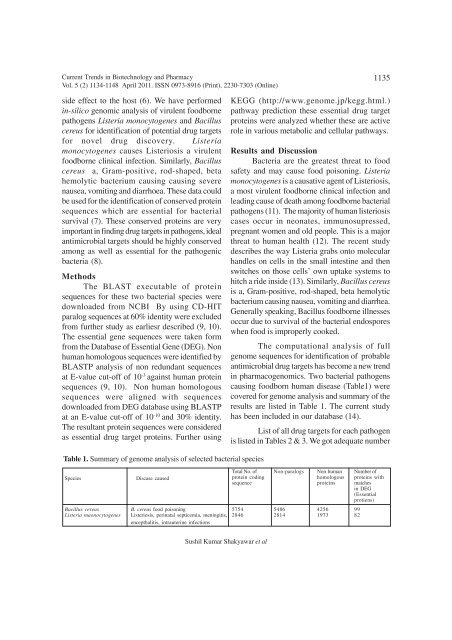full issue - Association of Biotechnology and Pharmacy
full issue - Association of Biotechnology and Pharmacy
full issue - Association of Biotechnology and Pharmacy
- No tags were found...
You also want an ePaper? Increase the reach of your titles
YUMPU automatically turns print PDFs into web optimized ePapers that Google loves.
Current Trends in <strong>Biotechnology</strong> <strong>and</strong> <strong>Pharmacy</strong>Vol. 5 (2) 1134-1148 April 2011. ISSN 0973-8916 (Print), 2230-7303 (Online)1135side effect to the host (6). We have performedin-silico genomic analysis <strong>of</strong> virulent foodbornepathogens Listeria monocytogenes <strong>and</strong> Bacilluscereus for identification <strong>of</strong> potential drug targetsfor novel drug discovery. Listeriamonocytogenes causes Listeriosis a virulentfoodborne clinical infection. Similarly, Bacilluscereus a, Gram-positive, rod-shaped, betahemolytic bacterium causing causing severenausea, vomiting <strong>and</strong> diarrhoea. These data couldbe used for the identification <strong>of</strong> conserved proteinsequences which are essential for bacterialsurvival (7). These conserved proteins are veryimportant in finding drug targets in pathogens, idealantimicrobial targets should be highly conservedamong as well as essential for the pathogenicbacteria (8).MethodsThe BLAST executable <strong>of</strong> proteinsequences for these two bacterial species weredownloaded from NCBI By using CD-HITparalog sequences at 60% identity were excludedfrom further study as earliesr described (9, 10).The essential gene sequences were taken formfrom the Database <strong>of</strong> Essential Gene (DEG). Nonhuman homologous sequences were identified byBLASTP analysis <strong>of</strong> non redundant sequencesat E-value cut-<strong>of</strong>f <strong>of</strong> 10 -3 against human proteinsequences (9, 10). Non human homologoussequences were aligned with sequencesdownloaded from DEG database using BLASTPat an E-value cut-<strong>of</strong>f <strong>of</strong> 10 -10 <strong>and</strong> 30% identity.The resultant protein sequences were consideredas essential drug target proteins. Further usingKEGG (http://www.genome.jp/kegg.html.)pathway prediction these essential drug targetproteins were analyzed whether these are activerole in various metabolic <strong>and</strong> cellular pathways.Results <strong>and</strong> DiscussionBacteria are the greatest threat to foodsafety <strong>and</strong> may cause food poisoning. Listeriamonocytogenes is a causative agent <strong>of</strong> Listeriosis,a most virulent foodborne clinical infection <strong>and</strong>leading cause <strong>of</strong> death among foodborne bacterialpathogens (11). The majority <strong>of</strong> human listeriosiscases occur in neonates, immunosupressed,pregnant women <strong>and</strong> old people. This is a majorthreat to human health (12). The recent studydescribes the way Listeria grabs onto molecularh<strong>and</strong>les on cells in the small intestine <strong>and</strong> thenswitches on those cells’ own uptake systems tohitch a ride inside (13). Similarly, Bacillus cereusis a, Gram-positive, rod-shaped, beta hemolyticbacterium causing nausea, vomiting <strong>and</strong> diarrhea.Generally speaking, Bacillus foodborne illnessesoccur due to survival <strong>of</strong> the bacterial endosporeswhen food is improperly cooked.The computational analysis <strong>of</strong> <strong>full</strong>genome sequences for identification <strong>of</strong> probableantimicrobial drug targets has become a new trendin pharmacogenomics. Two bacterial pathogenscausing foodborn human disease (Table1) werecovered for genome analysis <strong>and</strong> summary <strong>of</strong> theresults are listed in Table 1. The current studyhas been included in our database (14).List <strong>of</strong> all drug targets for each pathogenis listed in Tables 2 & 3. We got adequate numberTable 1. Summary <strong>of</strong> genome analysis <strong>of</strong> selected bacterial speciesTotal No. <strong>of</strong> Non-paralogs Non human Number <strong>of</strong>SpeciesDiscase causedprotein coding homologous proteins withsequence proteins matchesin DEG(Essentialprotiens)Bacillus cereus B. cereus food poisoning 5754 5486 4256 99Listeria maonocytogenes Listeriosis, perinatal septicemia, meningitis, 2846 2814 1973 82encepthalitis, intrauterine infectionsSushil Kumar Shakyawar et al













